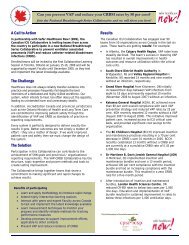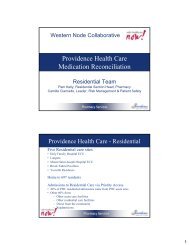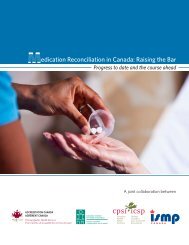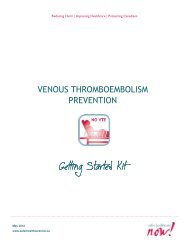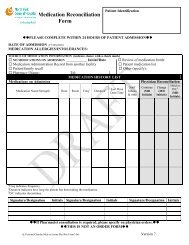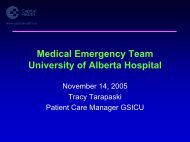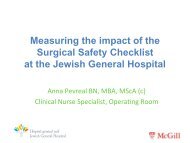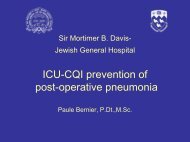VAP Getting Started Kit - Safer Healthcare Now!
VAP Getting Started Kit - Safer Healthcare Now!
VAP Getting Started Kit - Safer Healthcare Now!
You also want an ePaper? Increase the reach of your titles
YUMPU automatically turns print PDFs into web optimized ePapers that Google loves.
<strong>Safer</strong> <strong>Healthcare</strong> <strong>Now</strong>! Prevent Ventilator Associated Pneumonia <strong>Getting</strong> <strong>Started</strong> <strong>Kit</strong><br />
detail, and supporting evidence is presented in this section. The daily evaluation of readiness for<br />
extubation involves two central issues: minimization of unnecessary sedation, and testing the<br />
patient’s ability to assume unassisted breathing while still intubated.<br />
Minimization of unnecessary sedation<br />
Sedation has traditionally been prescribed in mechanically ventilated patients in order to<br />
maintain comfort, decrease pain and anxiety, improve patient-ventilator interaction, help<br />
maintain major organ homeostasis, facilitate nursing care by avoiding self-injury and to allow<br />
safe completion of daily activities and procedures. Unfortunately, over sedation may lead to<br />
unintended consequences, such as longer duration of mechanical ventilation and ICU stay,<br />
decreased communication with patient with consequent decreased ability to evaluate the<br />
patient for – among other items - delirium, weaning and readiness for extubation, as well as<br />
ventilator-related complications)such as neuromuscular weakness and pneumonia. 58<br />
In 2000, Kress reported the results of a randomized controlled trial in which 128 adult<br />
mechanically ventilated patients sedated by continuous IV infusion received either daily<br />
interruption of sedation (irrespective of clinical state) or sedation interruption at the clinician’s<br />
discretion. 59 Interruption was considered complete if the patient could perform 3 of 4 items on<br />
command: open eyes, squeeze hands, lift head and protrude tongue. Daily sedation interruption<br />
was associated with a marked and highly significant reduction in time on mechanical ventilation<br />
from 7.3 days to 4.9 days (p=0.004). Schweickert et al performed a post-hoc analysis of the<br />
Kress trial and found that patients undergoing spontaneous awakening trials via daily<br />
interruption of sedative infusions experienced significantly less complications associated with<br />
mechanical ventilation (<strong>VAP</strong>, upper gastrointestinal haemorrhage, bacteremia, barotrauma,<br />
venous thromboembolic disease, cholestasis or sinusitis requiring surgical intervention) than in<br />
those subjected to conventional sedation techniques (2.8% vs. 6.2%, p =.04). 60 In addition, these<br />
patients had a reduced ICU length of stay and were not at risk for worse psychological outcomes<br />
(anxiety, inability to cope with pain) after critical illness compared with conventional<br />
therapies. 61<br />
In an important proof-of-concept study by Strom et al showed that a no-sedation approach in<br />
mechanically ventilated ICU patients is associated with an increase in days without ventilation. 62<br />
In reality, as the intervention (no sedation) group was administered morphine as required, the<br />
true concept demonstrated was rather that a conservative approach of less sedation does not<br />
appear to cause harm in critically ill mechanically ventilated patients. Three caveats for this<br />
study are 1) the intervention group (“no” sedation) had a greater incidence of delirium, 2) the<br />
trial utilized more than usual resources, i.e. 1:1 patient: nurse ratios for all patients, 3) the trial<br />
was a single center study. A multicentre study is required to ascertain the reproducibility of<br />
these findings. In an observational study of 335 patients admitted to a mixed medical-surgical<br />
ICU, Salgado observed that minimal use of continuous sedation (42% of patients received some<br />
sedation, and only 10% of patients received sedation for >24 hours; 20% of ventilator hours were<br />
accompanied by a continuous sedative infusion) was feasible without apparent adverse effects<br />
(e.g. self-extubation requiring re-intubation). 63<br />
Interventional studies assessing the effect of implementing an ICU sedation protocol alone have<br />
provided inconsistent outcomes with respect to ventilator and ICU days, incidence of <strong>VAP</strong> and<br />
June 2012 16



